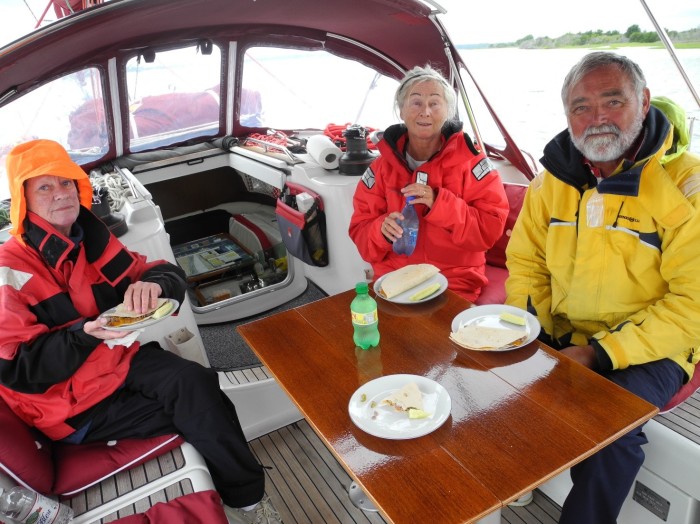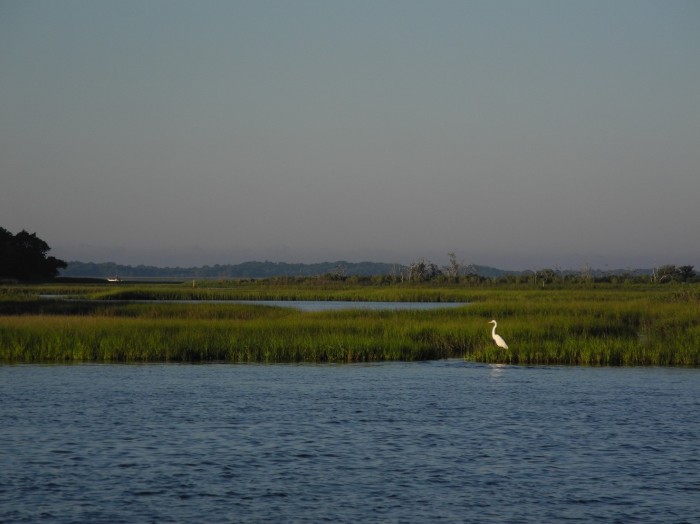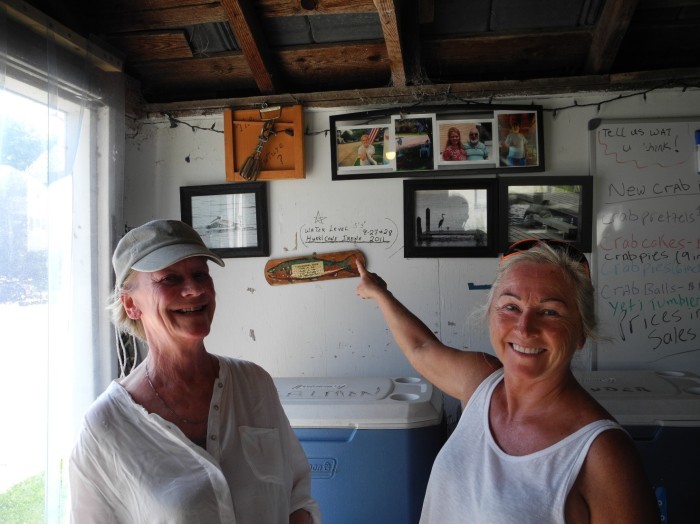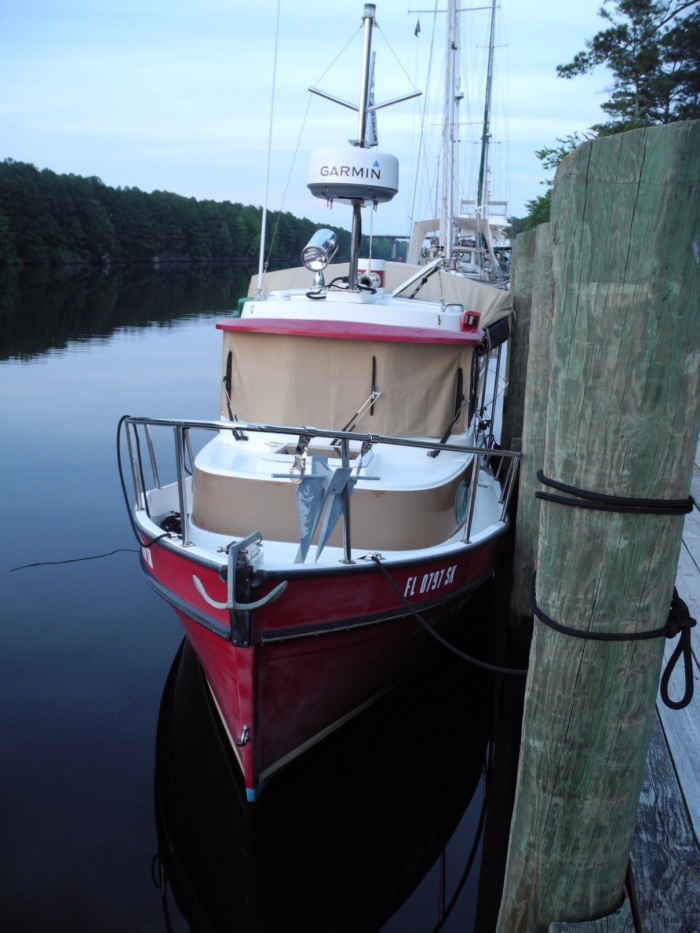We are going inland with SY Capri but it may be unrealistic. The local tribes say it is quite unthinkable. With seven feet, your draught is far too much, they say. Vinni and Carsten – Master and Commander respectively or is the other way around, on S/Y Capri – disagree on this. Carsten is convinced. He insists, we just have to take it easy. And moreover, they dredge from time to time, he says. And he is right. He has read it in the pilot.
Thus encouraged, and while the pelicans inquisitively – skeptically? – follow our maneuvers; we slip our lines at Carolina Beach, just a bit south of Wilmington, NC. Our adventure is just about starting, we are going north through rural America and the Atlantic Intracoastal Waterway to Norfolk, VA, and from there with a little bit of offshore sailing to Manhattan’s unrivaled skyline.
Atlantic Intracoastal Waterway
The Atlantic Intracoastal Waterway is part of the inland waterway which runs app. 2.600 nm from Boston southward to Key West in Florida. It is an important, navigable route without the hazards of the Atlantic for both commercial shipping and the 13.000, primarily American and Canadian, recreational boaters who make their way from north to south – or in the opposite direction – each year.
There is just one minor difficulty: Depth. Even though federal law provides for the waterway to be maintained by the US Army Corps of Engineers at a minimum depth of 12 feet for most of its length, inadequate funding has prevented that. Shoaling or shallow waters are encountered along several sections of the waterway, with these having 5-foot minimum depths from earlier improvements. And 5 feet is quite critical when your draught is 7. But if you are a modest motor boat with a less ambitious draught, the Atlantic Intracoastal Waterway is an obvious opportunity to experience a US which is unknown to most Danes. And if you have unlimited time at your disposal, the AIW is only the beginning of what you can experience. In fact, the AIW is just a smaller part of what people in the know call The Great Loop which is the vast, maritime infra structure that runs 5.200 nm all around the eastern USA, south of – or through – Florida, along the Mexican Gulf, up the Mississippi to the great lakes and southern Canada, and back to the Atlantic. Those fortunate enough to have sailed the The Great Loop fly a golden pennant, those who are under way have to fly a white.
Although our ambitions are far from that, they cause quite a stir. All we want to do is navigate our seven feet up to Norfolk. Our mast will not be a problem, all fixed bridges have air for 64 feet, and we have an air draught of 61.
The ceiling is low, the sky is grey, and so is the water. It has just stopped raining, it is hot and humid, and the wind fresh in the gusts. However, we will go by engine and have set – very optimistically – a goal for day: 75 nm miles

Vinni and Bente on watch
If we can reach that goal, we of course do not know. One of the great unknowns are the many natural inlets which connects the AIW with the immense Atlantic Ocean, and where tides and currents reorganize the shoals daily without the navigational markings following the changes. Apart from that, navigation is simple, although the markings some places can be quite far apart. Keeping an eye or two on the depthfinder and the chart plotter is essential. We try to keep us precisely in the middle of the dredged routing, which is quite narrow. And the markings in the canal may be placed a few feet off line.
– 9 feet, Vinni suddenly reports from the helm. At once she decreases speed to 3 knots. And then rapidly, 8, 7 feet, although neither charts nor pilot report any likely problems here, where we are passing one of the numerous inlets. 6 feet, Vinni says, and now we can feel the ground. She adds a bit more throttle, and we are through. Depths increase, and soon we are back at normal speed. I move the blue ‘post-it’ on the paper chart in the saloon one notch north. Keeping tack on progress is adamant.

Watch change – new helmsman and lookout
Looking out for the next mark, red or green, number, colour of water, difference in waves, whatever … binoculars at hand constantly. Not a single sailboat around. But a huge number of motor boats in all sizes. They all share one thing: Forests of fishing rods, which to the untrained eye look like tools for big game hunting. And then of course they all share one more thing: A modest draught. Their crews look at our national flag at the stern with some curiosity, they wave, and then they pass us with great speed and often deep contempt for the ‘no wake zone’ signs that are meant to protect the vulnerable banks against swells and erosion.
We move forward through the landscape, which still close to the banks is densely populated with the characteristic, beautiful American wooden houses, many of which today seem to be built in plastic – cheaper construction, easier to maintain. Most of them quite large – at least by Danish standards – and elevated on pillars to withstand the frequent hurricanes and floods. Everywhere piers, bridges and dock houses with davits for boats in all sizes. Man and boat in attractive symbiosis.
Red Nuns
From our guide (Dozier’s Water Way Guide) we know that between red nuns 72B and 72A, where there is a long and crooked inlet from the ocean, depths may not be what they seem. Consequently, we proceed with the utmost caution, slowly and as advised in the port side of the channel. But we feel the bottom. Putting Capri in reverse and then forward again we try a bit more to the port side. Same result and we have the tide against us. From the opposite direction, a rare sailboat is approaching us. They too seem to have problems getting through but manage after all to their port side. On the radio, we learn that their draught is only five feet.
One more time we put in reverse, then forward, and try starboard side with some more revs to see if we can force our way through here or there. No such luck, and now we are stuck. Now it is indeed very good that Capri subscribes to Tow Boat US, which for an annual fee of 149 USD provides unlimited and 24/7/365 towing assistance. Carsten makes a phone call. The local tug will be with us in a hour. Now, Carsten changes into one of his other manifestations, Maitre de Cuisine: Hot fold-overs with roast beef, jalapenos and lots of cheddar. Spot on, on a grounded ship.

Lunch while we wait for tow boat
And then suddenly, round the corner the little red tug appears. High speed. One bearded man, solid competence, – and ’no problem, Cap, I’ll get you off and through’. So it goes. After a short while and a concentrated effort with the big Suzukis, our new friend has dug a small canal for us through which he tows us to relative freedom on the other side of the obstacles.

Tow boat to the rescue
And he is surely impressed. 7 feet is quite something in this part of the world, and he will not guarantee that we can continue unhindered when we are leaving his turf. Good luck, he salutes us as he returns to the other side. He is quite right. Before we reach Swansboro and Casper’s Marina after 35 nm and 9 hours motoring we have touched soft bottom a few more times. In Casper’s the dock master has left for family and grill. We save docking fee. No problem whatsoever. With Vinni and Carsten we are self-catering in all aspects.

Sundown in Caspers Marina – Swansboro
Nature galore – and dinghy in distress
Leaving Casper’s Marina with the sunrise, civilization thins out. Houses, piers and boats fade away, nature takes over. Our guide tells us that we are entering one of the world’s most varied habitats. We are easy to convince. Close by we see dolphins, sea otters, and birds, birds, birds, pelicans, shore birds, hawks, and falcons. Almost every larger nautical marking is inhabited by busy, feathered families in impressive nests. As we get closer we are warned by alarmed parents not to get too close.

With all this ’yelling’ navigating in a fog will be no problem. We – I am sure – even manage to see a couple of the national eagle with the characteristic bald head, the feathers at the tips of its wings that are widely separated, and its relatively short tail which is usually fanned open. As we get closer they disappear behind the treetops. According to local ornithologists the bald eagle is back in decent numbers, even in North Carolina, and now longer considered endangered. Manatees should also be around, and even alligators. Alligator River is around one of our corners. But first of all, Capri’s dinghy needs attendance. It cannot its breath, and Carsten has identified a specialist in Oriental who has promised to bring it back to life. Thus, after 38 nm in, so to speak, untouched nature and a US Marine Corps firing range, we throw our lines in North Carolina’s Sailing Capital.

Oriental
On the radio, we have made arrangements with Oriental’s dock master that he will take our lines at the outer pier where depths should be alright even at low tide. Mark is a happy man, and he is on bike. With many gestures, he directs us cautiously to a tiny spot at the stern of a sincere motherfucker of a Jamaican motor yacht that communicates with a lot of x-mas lights and other fancy stuff. Our sonar says 7 feet straight. But that’s OK even though we would like to have our stern the other way. That may be changed later.
‘Sailing Capital’ may seem a bit opulent. But nevertheless. The boat people ratio in Oriental is a convincing 3.000 boats to 900 souls. And the local economy to an overwhelming degree seems to be based on servicing the needs of local and transient boaters including quite a few sailors. And then some quite impressive shrimp trawlers. The real name, Oriental dates back to the 1880s where he the postmaster’s wife thought that the aspiring, small community should not be named Smith’s Creek as her husband suggested, but something with a bit more swung. So Oriental it was, named after the Federate steam-sail transport ship, Oriental, which in 1862 thoroughly ran aground at the nearby outer banks.
Oriental is a beautiful place, a state of mind, and a world of yesterday with small or modest, well-kept houses and lawns, many with a boat on trailer. In the streets one greets one another, give hands, present one selves, small talks, this and that. Life is slow, and the front doors are un-locked during nights. A cooling breeze coming in from Pamlico Sound. The news of the day, the large national papers are not to be found, so on a weekly basis, Pamlico News offers ’responsible community news’ and ’homegrown advertisers’ – ‘hurricane season has just started, check your insurances’. City center, if one may call it that, seems a bit un-focused but stretches along the harbor front. The inn, a few restaurants, a gallery and a very few shops including the local fishmonger – Garland Fulcher Seafood – operating out of a colorful and wonderful shack opposite the shrimp trawlers’ pier. We buy groupers. With Carsten’s mushroom sauce, we are in for a feast.

high water mark – hurricane Irene
If larger amounts of grocery is needed you have to leave city limits. And if don’t want to walk you are free to take one of the un-locked bikes at the Oriental Trading Company. The wife and I walked but was returned from Piggly Wiggly by car chauffeured by a local woman who saw us struggling with our big bags. And then we got a new, healthy talk.
In Oriental, we also witnessed the historical generosity which is so pronounced and characteristic for many, small communities all over the US. At many of the houses – or whatever the local historical association thinks is worth mentioning – a small, individualized, and often artic poster is set up, telling the story that was and still is, big or small, about the very local contribution to the greater community. This, I believe, creates coherence and overview in past and present, without having you to visit the local museum or archives. And if you are a strong believer in ‘history sucks’ you can just walk by.

The ship pictured on the sign is the Oriental
The day after, Capri’s dinghy has returned to its former grandeur, and we have miles to go: 80 nm to Alligator River Narbor
We are all awake before sunrise which indeed is beautiful and promising. One more splendid day awaits us. We brew tea and coffee, more substantial breakfast must wait. The big Jamaican has left during the night – surprise, surprise no reggae, no jingle bells, no hooting, and it’s easy for us to enter the open but shallow Pamlico Sound. For the first long stretch, we have to follow the coastline before we make our way into Goose Creek, from where we have to cross Pamlico River to reach a waypoint at Belhaven and the entrance to the long and varied Alligator River-Pungo Canal. And now our sailing again turns into a fantastic, desolated nature trip. In the beginning the landscape is open, marsh-like, the horizon long, and the light overwhelming. But as we proceed north, the banks are thickening, forest and threes are becoming dominant. It is like sailing on a river in a rainforest. Navigation is now even more demanding, we have to be dead certain that we are in the middle of the track, no excursions. Just outside our narrow path are tree stubs in abundance. Some of which so nasty that they cannot been seen until you are almost just above them. Moreover, logs of considerable sizes which seem to have a fondness of being absolutely in the middle on the road complicate our routing. Alligators? We see none. Neither bears, which are said to swim over the canal as they like. But fishes breaks the water all the time, and then of course birds, birds, birds. At the banks and in the water deer graze the low hanging, green leaves of the trees.

Human ’colonizations’ are far apart and other boats we only see from time to time. Mobile net, naturally, is not existing. Early in the evening, the landscape again broadens up, and we are now colonized by some swallows which nosily have fallen in love with our spreaders and take a keen interest in our doings. At 7 pm we pass the Alligator River Swing Bridge and enter Alligator River Harbor. By radio, we have informed the Alligator dock general about our arrival and asked for advice in the falling tide. No problem, plenty of water, 9 feet at least. But Vinni must force her way through the entrance with a heavy foot on the pedal. In the sparsely visited harbor, we found a promising spot at the fuel dock, and asked about the alligators. Plenty, plenty, they hang around just on the other side of the road. The other day, one of the great males took residence at the diesel pump. That sort of hampered commercial life at the dock for most of the day. Documentation, a photo on a smart phone was convincing, and the nightly excursions to the restrooms were quick, cautious and efficient. However, we did not meet any, which in a strange way was kind of sad. On the other hand, we meet a lot of bloodthirsty mosquitos. Which may also be the reason why only two other not-at-all-local boaters, are joining us in Alligator River Harbor. A Canadian in a Beneteau 36 and a former sail-boater from Florida, who has invested in a small motor boat to join the great loop party.
Towards Great Bridge
From Alligator River Harbor and further up north to Great Bridge just before Norfolk there are two possibilities. Both of them sound exotic: The Great Dismal Swamp and The Virginia Cut. Unfortunately, the Great Dismal Swamp is off limits for Capri. The most recent hurricanes have displaced shoals, mud and trees to such a degree that both our water and air draught disqualify us from entering. This is a real shame, the name is quite promising, and more over because of the latest, great American novels, Colson Whitehead’s The Underground Railway, is said to take part at least to some extend in the swamp. The novel which has been widely acclaimed, awarded, and included in Obama’s summer reading last year, chronicles the slaves’ clandestine networks, safe houses and escape routes through dense forests and impenetrable swamps to freedom in the north. (I have not read it – yet, I have to admit.)
Instead we take the Virginia Cut which is absolutely also a great experience although the maritime traffic is now growing significantly. We encounter several tugs, pushing huge barges at considerable speed. First, we learn about on the VHF, where the tug caps agree with other boaters how to pass each other safely. And then we see them coming foaming against us. Now, when it is our turn, we naturally stress that we too are hampered by our draught. I am sure, they are very impressed, everything goes smoothly, and both parties exchange good wishes for a continued safe journey.

Buildings and houses and still not the order the day, instead tree stubs and logs aplenty. We feel the presence of the nearby Dismal Swamp. But then suddenly out of nowhere a small ‘trading station’ with a barber (!), a food joint and a post office appears. This is Coinjock – named so by the Indians because of the wild berries growing in the area. But as none of us needs a haircut that much, is hungry and has mail to send we continue towards civilization.
Early evening and after 10 hours motoring we are closing in on Great Bridge and the Atlantic Yacht Basin, where we are promised a dock. This will be our last stop before we enter Norfolk’s enormous port on our way to the ocean and New York City. Atlantic Yacht Basin, which is close to Great Bridge Battlefield where one of the earliest and most critical battles for American independence took place in December 1775, is a quaint, bizarre, and charming gem of an authentic boat yard with a long history and ownership of one family through several generations. As a transient visitor with only one short evening to explore the premises it is compelling. Shackss, workshops and maritime railroads where shipwrights and enthusiasts seem to work round the clock on all sorts of classic boats and fanciful floating objects in different stages of restauration and renovation. Here there are no sexless, sterile parking lots and over branded shops.

Great looper
This is a surely a place where Kenneth Grahame’s saying in his classic childrens’ book The Wind in the Willows gets new life: “Believe me, my young friend, there is nothing – absolutely nothing – half so much worth doing as simply messing about in boats.”
And we made it. Contrary to what local experts said, we got all 7 feet of Capris draught safely through the
The Atlantic Intracoastal Waterway without meeting major obstacles. That is also noticed in Great Bridge and at the wooden pier in Atlantic Yacht Basin, where we among other sailboats see a Norwegian Colin Arches whose crew is said to be visiting Washington DC.
Tomorrow, we just have to go through the Great Bridge lock. Then we will be in real, salty waters again. That we will deal with later.
By the way: With the experiences from the Atlantic Intracoastal Waterway, Vinni and Carsten might be tempted to encounter the Northwest Passage at later stage as well. That will also be a completely different story.


